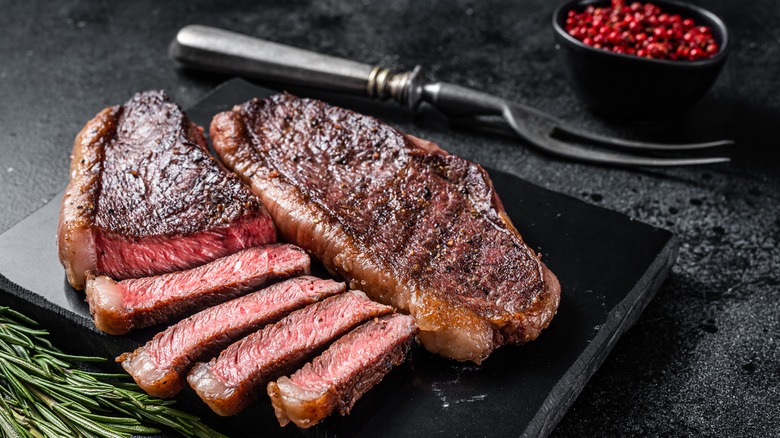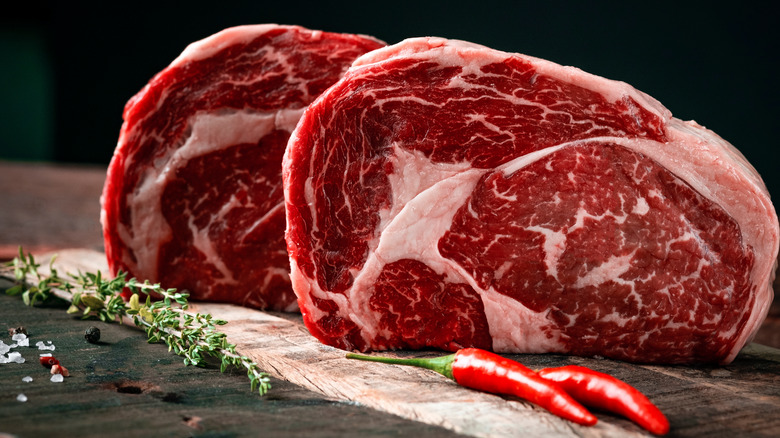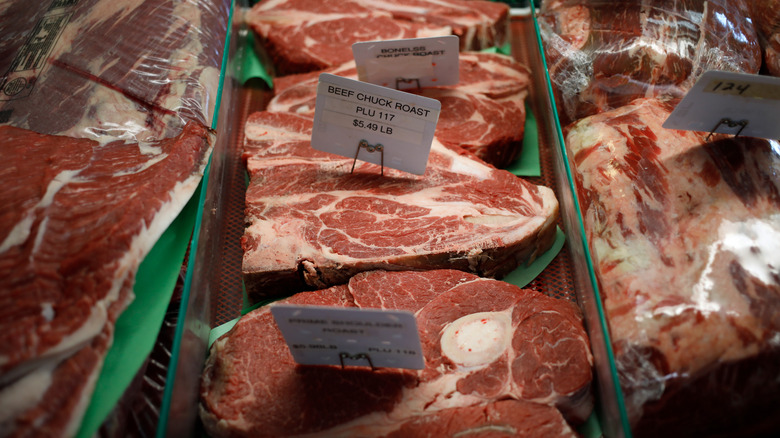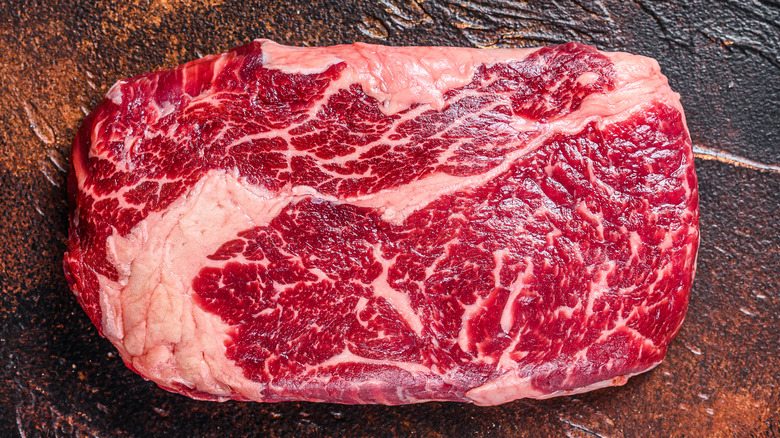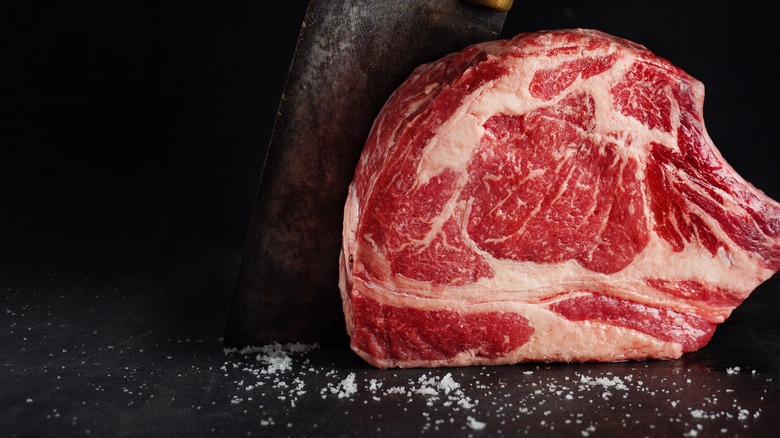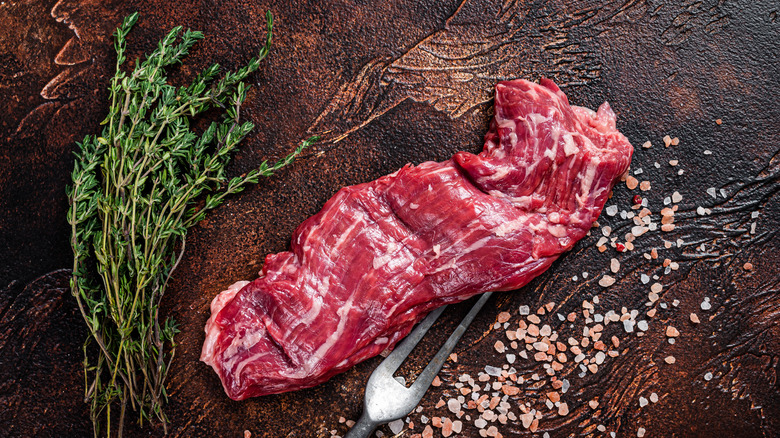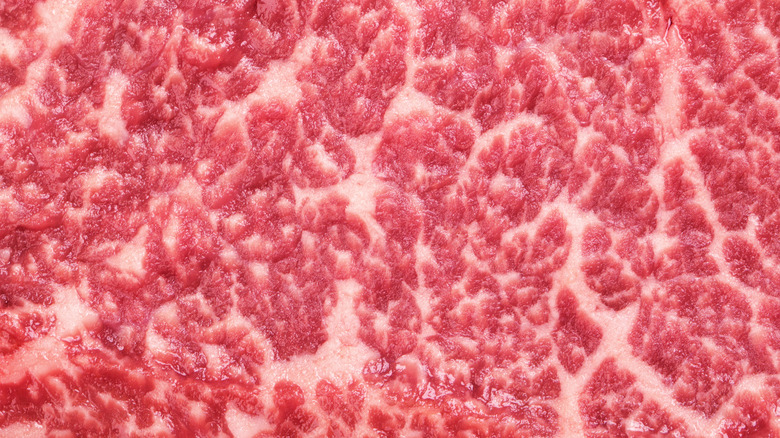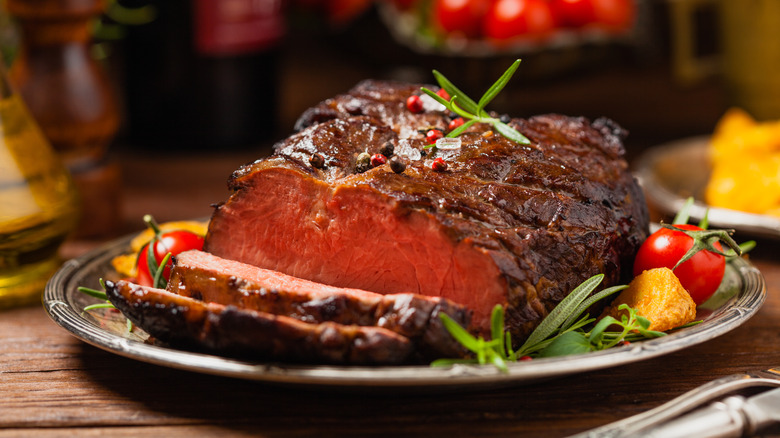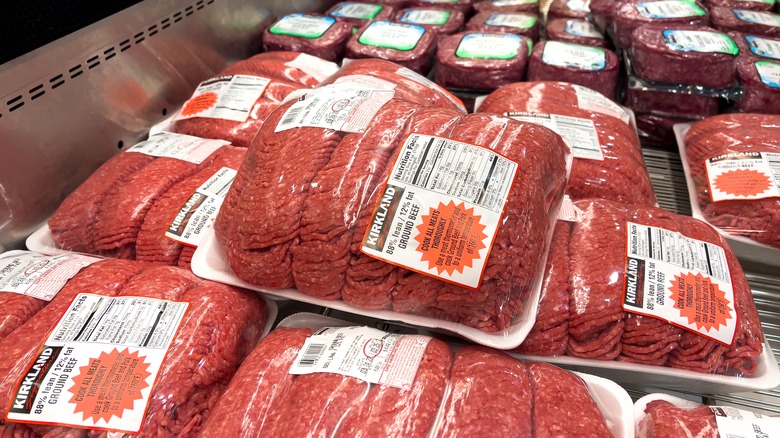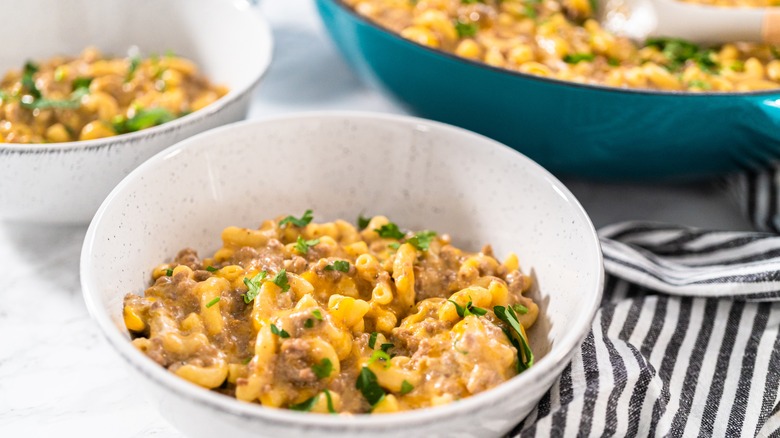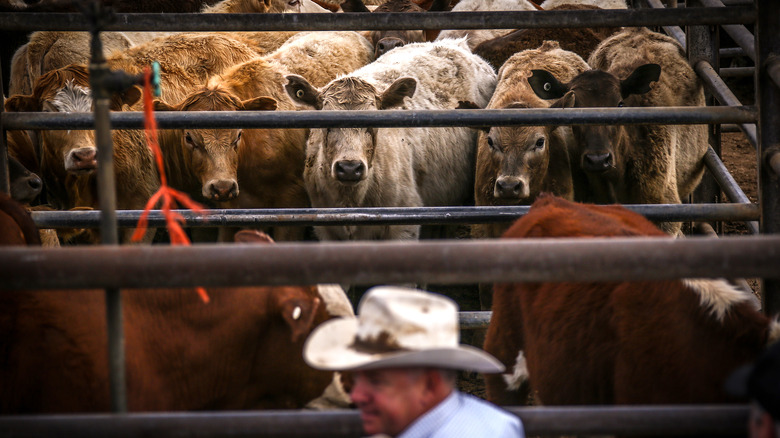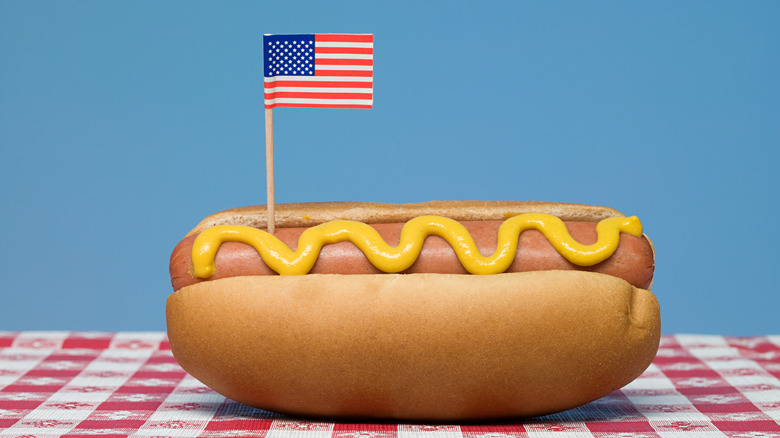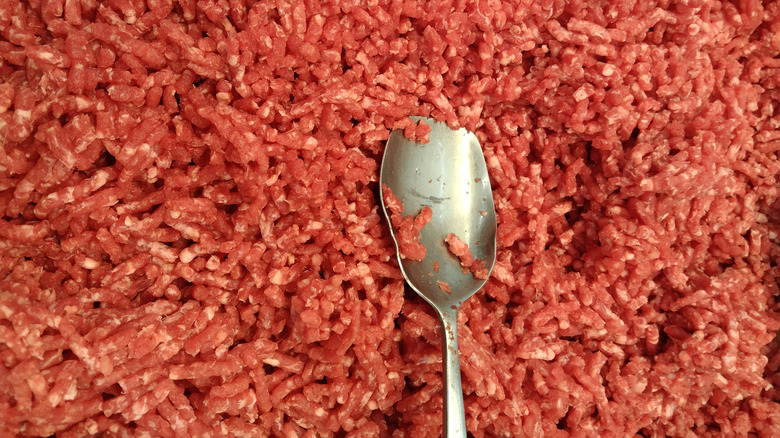All The Facts About Steak Grades Explained
As it turns out, grades aren't just for school, they're also for meat! The U.S. Department of Agriculture (USDA) has designed a system of ranking meat that may sound familiar. Perhaps you've seen meat described as "prime" on a restaurant menu. After all, who doesn't want a prime choice of meat? As Beef Magazine notes, these rankings really go beyond prime. There are actually eight in total that range from the gourmet Prime to the lowly Canner.
These rankings were first developed in the 1920s, and according to the USDA's official website, created a systemized approach to beef that made it easy for farmers and consumers to produce and purchase. The process is carried out by USDA-appointed employees, or graders, who rank the meat individually with different methods and tools at hand (via USDA). This grading system has been nothing but revolutionary for the meat industry and allows consumers to know exactly what they're buying — provided the grades are visible or attainable. Beyond this, there are plenty of things that may surprise you about how, and why, beef is ranked the way it is and what this means for our beloved steaks.
Prime, choice, and select are the most well-known steak grades
In the world of meat, Beef Magazine points to Prime, Choice, and Select as being the most widely available, and prized, on the U.S. market. These steak grades are more often than not found in restaurants, butcher shops, or grocery stores. However, there is also: Standard, Commercial, Cutter, Utility, and Canner.
One might wonder, of course, what separates each steak grade. The answer is a bit complicated, but we're going to unpack it. The folks over at Las Vegas Weekly do their best to take a stab at the iconic red meat. They conclude that age, marbling, and muscle are the most important factors in the grading system. This means that a lot goes into measuring what makes a good slab of beef! Given how much Americans love steakhouses and beef in general, it's no surprise that our federal agencies would look deep into separating the good from the bad.
Basically, the better the marbling, the higher it "ranks" on the grading system (via Las Vegas Weekly). Prime beef will thus be the youngest and fattiest, or most marbled cut of meat with good structure from healthy muscles.
There are two main categories: quality and yield
While there are several grades of meat there are also two major categories to differentiate between any and all beef: quality and yield. The names may seem if not familiar, at least straightforward, and can lend valuable insight into the type of steak you're buying (via Beef Magazine).
Daryl Tatum with the Colorado State University Department of Animal Science wrote a comprehensive field guide to appreciating the two different grading systems. Quality, he pointedly noted, should really be understood as the "expected" quality of the piece of meat. He observed that tenderness, flavor, and juiciness are the major factors for each grade of beef, and physical factors like the amount of fat (marbling) in the cut, as well as its age, will guide graders to determine the cuts clearly. Beef can only be ranked as prime beef when it's 9 to 30 months old and has the highest amount of marbling possible.
Yield, on the other hand, focuses on just how easy it is to cut the overall cow carcass. The more muscle a piece of beef has, the tougher and chewier it will be, while the more fat will result in a softer cut. Simply put, yield 1 and yield 5 grades are the highest and lowest grades respectively. This particular subcategory tends to come less into play with everyday consumers.
Prime beef accounts for 3.5% of US beef
There's a reason why prime beef is so well-known: It's the choicest of cuts. Prime beef is simply the best of the best, and there's a good reason to back this up. According to a report from Robert Holland at the Center for Profitable Agriculture, this particular beef grade is the most palatable, tender, and flavorful. It takes a lot to be recognized as prime beef: The beef needs to be sourced from young cattle that are under 30 months old and chock-full of all of those fats that make steak so mouth-watering (via Extension University of Wisconsin).
Given that it takes a lot to qualify as prime beef, it's no surprise that it's not as abundant as other cuts. So select is graded as prime beef, in fact, it makes up only around 3.5% of all beef that was sold in 2021 (via Beef Magazine). It should be noted though, that the quality of what qualifies as prime has become more lax as of late, but more on that in a minute ... So, when looking at prime on the menu, don't be shocked to see higher prices accompanying it! It's a luxury treat, that's sure to make any steak lover's heart flutter and stomach moan when paired with say the likes of a ribeye steak.
Prime's fine marbling can make it expensive and difficult to find
Prime beef is going to make for the fattiest of beef grades. This fattiness, while it may not sound appealing to some, is just what gives this particular grade its amazing texture and flavor. For some luxury diners, there is simply no other choice than to go all out, and when indulging with a fantastic tenderloin steak, why not enjoy the best of what America's cattle ranchers have to offer?
Even in trying times, some gourmands still try to make room for pleasure, and in 2022, despite inflation, Prime beef was trending upward in sales, according to Beef Magazine. This is pretty astonishing given that the beef grade's prices have simply sky-rocketed in the years surrounding the pandemic. Prime prices were 46% higher in early 2022 when compared with 2020 prices.
Those who still love to indulge on this pricey piece of cow, despite the major price point, may be surprised where to best buy it. My Chicago Steak noted that grocery stores, even high-end ones, tend to not keep a lot of Prime beef in stock. Some grocers have limited storage space to work with and may not expect to sell much gourmet foodstuff. Thus, My Chicago Steak suggests ordering Prime beef from specific retailers that specialize in beef and steak. The U.S. has a number of mail-order steak options that can bring a piece of Prime beef right to your door!
Choice beef has long been overlooked
With all the hype surrounding Prime beef, one might be surprised to learn that Choice cuts can be just as good a choice! As noted by Daryl Tatum, Choice grade beef is going to be just as young as Prime. What really differentiates the two is marbling: Choice is the slightly leaner option. But, as Serious Eats notes, in reality, it may not be as cut and dry as the rankings imply.
As Serious Eats observed, not all beef specialists agree that marbling is indicative of the best cut of meat. Thus, just because Choice beef may have less fat than Prime may not mean it's any worse off. The site also notes that Choice beef tends to have less marbling because it's sourced from grass-fed beef, which some argue tastes better than the usually grain-fed Prime beef grade cuts. Because more and more beef is being qualified as Prime now, the quality is beginning to drop: Grocery stores are more likely these days to have Prime that barely qualifies in the category but at the same higher price. Ergo, the Choice grade may be the best way to make steak, at a fraction of the cost.
Marbling should look a certain way when selecting grades
For those who prefer to have oodles and oodles of marbling in their steak, make sure to keep in mind just what this marbling is and what it should look like. One butcher, Michael's Meats, took to paper to make sure meat connoisseurs could make the most informed choice. The site notes that marbling doesn't mean outer or intermuscular fat. Instead, marbling is going to be the fat that's intramuscular, or in between the cut's muscles (via Golden Steer Steak Company).
This fat will contrast boldly with what should be the steak's deep-red flesh, as per Michael's Meats, and will be noticeable, purely white flecks of fat. It should never be yellowed or graying in any way. The overall steak should be firm, yet tender.
As explained by Golden Steer, marbling needs to melt in order to positively impact the steak cut's flavor. The steak maker's warned that any recipe under 130 degrees simply wouldn't allow the marbling to melt and enrich the beef's flavor. It's simply a waste of good marbling! As the steak company concluded, serving heavily marbled steaks as a blue steak will not be a fruitful endeavor, and steak masters should opt for a leaner cut when going blue.
Select beef can work well for certain cooking methods
Select beef tends to be written off with shoppers asking themselves, "If Choice is a worse Prime cut, then why even bother with Select?" But, in the right circumstances, Select grade beef can really be the most passable solution.
Select beef, while still just as young as Prime and Choice, has the least amount of marbling (via Extension University of Wisconsin). Tatum ranked the grade of beef as having very minimal marbling and lean, although not tough to chew. This beef grade is often the bridesmaid and never the bride, and has already had some PR spins. As per the Orlando Sentinel, at the tail end of the '80s Select grade beef was once known as "Good" beef. Fearing that consumers wouldn't enjoy the beef as much, the USDA opted to revamp the grade as "Select" to keep up with Choice and Prime.
Nonetheless, this particular grade still hasn't received its flowers. While it may not be the most tender of cuts, Select beef can still result in a tasty steak, with the right methods. For example, the USDA recommends, that due to its considerably lower fat level, it will taste best with a marinade and braising.
Standard is often sold as store-brand beef
Below Prime, Choice, and Select comes Standard, the last of the four widely sold retail beef varieties (via Beef Magazine). Standard is truly the tipping point in tenderness when it comes to the first four grades of American beef. It's the same age as the other three high-quality steaks, however, as noted by Tatum's beef grading synopsis, it contains virtually no marbling. Due to this lack of fat, Select grade beef is when young beef becomes tough and rough.
In fact, the USDA implies that there really isn't anything that will make this grade of meat steak-worthy: Its texture tends to not cook well on its own without the addition of sauces and modifications. Instead, the government agency notes that this beef grade is more often than not sold as store-brand beef. So, next time reaching out for ground beef at the supermarket, keep in mind the grading system and what this means exactly!
Commercial grade can still be used in the kitchen
Venturing into Commercial grade beef can feel like wading into uncharted territory, after all, what's beyond Standard? There is certainly something waiting for those intrepid in their love of beef. Commercial grade, as the name implies, is still fit for sale. It's older beef, and as defined by the USDA, sourced from cows that are 42 months of age. Once cows reach an advanced age, above 42 months, they are a completely different grade of beef altogether.
Although this grade of beef is older, it does have a moderate amount of marbling (via Colorado State University). This means that the beef has a slightly fatty texture that can still lend itself to cooking, although age will significantly detract from the beef's overall flavor. Needless to say, this isn't the beef that will give you the most high-end steak experience. Rather, it's for those who are willing to experiment with a lower-quality, but also a significantly cheaper option.
Utility, cutter, and canner grade beef are seldom found in the meat aisle
When it comes to strolling down the beef aisle, there are some options that simply aren't normally found on the table or sold in the grocery aisle as stand-alone beef. Utility, Cutter, and Canner beef, as each name implies, are not butchered for home or culinary use. The three lower grades are, according to the aforementioned Dr. Tatum, cut from mature cows like Commercial.
In contrast to Commercial, however, the three grades have very little marbling. In fact, Cutter is described as basically having no intramuscular fat, which may be where its intense name came from. Both Utility and Cutter are not really made for a high-end dining experience, though as Jonathan Campbell, an extension meat specialist, explained to The Takeout, you may still find them as a cheap meal on a buffet. As Modern Farmer opinioned, however, the best cooking tip for these USDA grades is simply to steer clear of this beef whenever possible.
Utility, cutter, and canner grade beef is however found in processed meats
As the USDA clarifies, Utility, Cutter, and Canner beef are only ever rarely sold in retail grocery stores. If you ever do find them sold separately in a grocery store, it's certainly a red flag! But, just because this quality of beef isn't regularly sold doesn't mean you haven't eaten them — though perhaps unknowingly. These beef grades are often used for, according to the USDA, used in ground beef production or processed beef products.
Though Modern Farmer observes it also isn't uncommon for uber-processed meats like hot dogs to use low-grade beef to make their fillings. In that sense, what one might write off as incredibly low-quality meat may just be an American staple. Notably, human consumption isn't the only use for these beef grades. Dog food will often use these low-quality beefs as filling, as per Modern Farmer. Perhaps this is why the name "Canner" came to be.
The grading system has roots in controversy
The history of beef grading is riddled with controversy, in fact, it started with it. Beef has long been a part of the U.S. cuisine, and a large beef industry is necessary to maintain this. At the turn of the century, Chicago wasn't just one of the major beef-producing cities, according to Smart Sense, it was the capital of beef production. There were many accounts that the working conditions in the city's beef manufacturing plants were both inhumane for the cattle and humans that worked in them.
The now-renowned journalist Upton Sinclair, who was only 26 at the time, worked undercover at one of the city's largest meat packaging plants. The conditions horrified him so much that he wrote an entire novel on the subject — "The Jungle." While the book now rests as a piece of American history that has reached both national and international acclaim, at the beginning of the 20th century, it was so controversial, that Sinclair had to go to pitch it to numerous publishers before getting the book in stores. "The Jungle" quickly had a significant impact, and went on to inspire multiple health and safety laws in the food industry by the 1910s. The USDA to this day acknowledges that Sinclair paved the way for major food safety reform that has directly impacted how safe American food is today.
Some grocers have butted heads with the system
The USDA beef grading system has been in effect for over a century, according to the University of Texas. While widely used and accepted, it doesn't mean that some retailers haven't tried to pull a fast one. This can even include major grocers, like Giant! As reported by The Washington Post in 2014, the supermarket chain opted to label all of its beef "USDA-graded." This was confusing for customers, as the label failed to specify which grade the beef actually was. It was hard, if not nearly impossible, for consumers to differentiate say Choice from Select with these new labels.
It seems like the labeling was a marketing trick to try to encourage shoppers to buy any type of beef, without any prejudices against its USDA grade. The Post also pointed out that this tactic was a cost-saving maneuver, to avoid using multiple labels. Food safety specialists, as well as officials at the USDA, voiced dissent that such practices are not only a food safety concern, but show a lack of transparency on the side of the grocer.
Some beef products have raised plenty of controversy
While we no longer quite have the same questions surrounding meat production pointed out by Upton Sinclair, it seems that these very questions have evolved and changed over time. In the 2010s, the internet reached a fever pitch with what was described as "pink slime" (via Food Safety News). The food news site observed that everyone from ABC News to bloggers were weighing in on the supposed risk, danger, and general grossness of what was essentially a meat paste that resembled, well, as the name implied, pink slime.
Food Insight clarifies that the slime was originally, and more accurately, referred to as Lean Finely Textured Beef or LFTB. The controversy laid into the contemporary debate surrounding artificial and organic foods, and many perceived LFTB to be supremely detrimental to health, though this was not entirely the case. There was so much controversy surrounding "pink slime" that eventually ABC News was sued by the beef product's South Dakota-based meat processing plant on grounds of defamation and misinformation (via The Counter). It's interesting to note that the history of meat safety and quality began with a journalist exposing the dangers of meat, and now recently encompassed a meat-processing plant successfully suing a news outlet — reportedly to the tune of $177 million!
